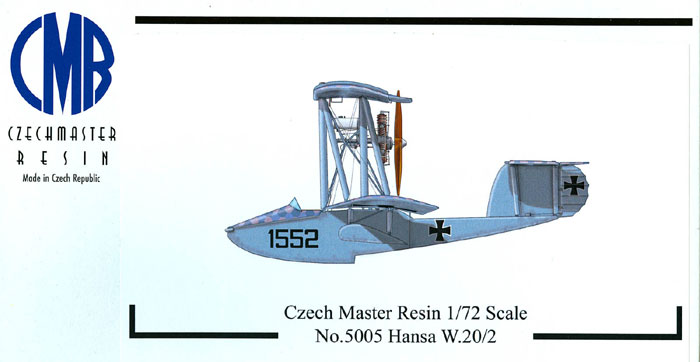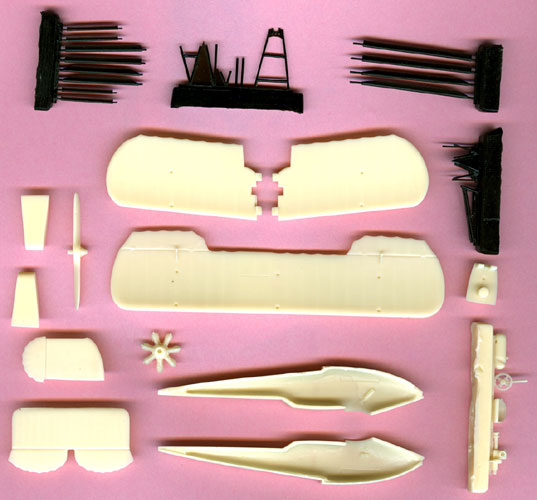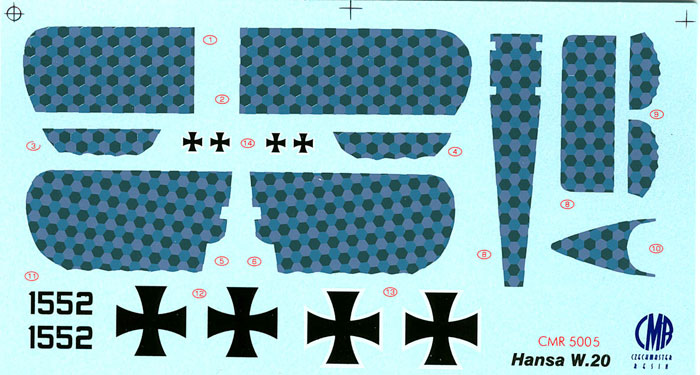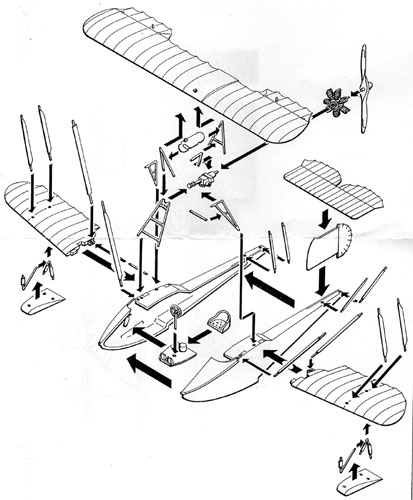|
Hansa-Brandenburg
W 20/2

Czech Master Resin, 1/72 scale
S u m m a r y
|
| Item No. |
CMR Kit# 5005 - Hansa-Brandenburg W
20/2 |
| Contents and Media: |
16 parts in buff and 24 parts in black coloured resin |
| Scale |
1/72 |
| Price: |
USD$55.80 available online from Squadron
from
£17.30 available online from Hannants
and specialist hobby outlets worldwide |
| Review Type: |
FirstLook |
| Advantages: |
Excellent detail with crisp casting
of parts, incredibly detailed engine, nice decal sheet with all items in register. |
| Disadvantages: |
Some simplification of lower wing
mount; fin appears too short. |
| Recommendation: |
Highly Recommended |
Reviewed
by Jim Schubert

CMR's 1/72 scale
Hansa Brandenburg W 20/2 is available online
from Squadron.com
The successes
of the German surface raider S.M.S. Wolf using a Friedrichshafen FF 33e
floatplane, “Wolfchen”, in her Pacific operations, prompted the
German Navy, in late April 1917, to order three scout planes from Hansa-Brandenburg
for carriage aboard large submarines. The “U-Cruiser” subs were to each
carry one plane, disassembled and stored in a 6.2’ (1.9M) x 19.7’ (6M)
watertight tube.
Critical to the
program was the speed with which the airplane could be extracted,
assembled and launched and the speed with which it could be recovered
disassembled and stowed. Realistic Navy tests took a practiced team
about 15 minutes for the former and about seven for the latter; Heinkel
and Co. claimed ridiculously short times on the order of six and three
minutes respectively.
Ernst Heinkel’s
original design produced a tiny biplane, pusher, flying boat with a wing
span of only 19.7’ (6M); this was W 20/1, s/n 1551. It was rather too
fragile having, for example, no interplane struts. It was heavily
damaged in testing. W20/2, s/n 1552 was built incorporating the lessons
learned from W 20/1. It had an increased wingspan of 22.3’ (6.8M),
interplane struts, relocated tip floats and increased strength
throughout.
Ironically,
during the building of W 20/2 the Navy cancelled the requirement for
carriage within a submarine. Their decision was driven by the
realization that wood and fabric airplanes were not suitable for
submarine duty.
Sometime after
June 1918 the Navy placed an order with Luft-Fahrt-GmbH (Roland) for the
all-metal, twin-float, monoplane LFG V 19 “Putbus” for use on
submarines. Only one Putbus was built before war’s end.
As the Navy had
ordered three W 20s, Hansa-Brandenburg rebuilt W 20/1 and strengthened
it even more than W 20/2. They then built W 20/3 in fulfillment of the
contract. The whole project was an exercise in futility and wasted
effort for Germany but led directly to the successful Japanese
employment of planes carried by submarines before, and during, WWII.
See…
http://www.internetmodeler.com/2002/july/new-releases/book_sub-ac.htm
One positive
result, for us, of all that wasted German effort was this attractive
little biplane scout that has attracted much attention from modelers and
kit makers. I know of at least four other kits of W 20/2:
-
Omega Models 1/32 scale, resin,
very good.
-
Lone Star Models 1/48 scale,
vac, very good.
-
Airframe 1/72 scale, vac, fair.
-
Merlin Models 1/72 scale,
injected, poor.
The now typical
and welcome CMR box encloses this little beauty. Beware! It really is
tiny. The wingspan is only 3 ¾” (94mm) and the length is 3 ¼” (82mm).
Due to the small size of this plane, compounded by its complexity, CMR
have had to simplify it in the area where the lower wing is mounted.
They’ve made a good compromise here but a serious AMSer will want to
complicate the wing mounting to make if more detailed and accurate.
Compared with the partial drawings, referenced below, the fin appears to
be a bit too short. From the various photos of this plane it also
appears the elevator had a very curved leading edge - almost a
semi-circle.
There are 16
parts cast in CMR’s standard cream-colored resin and 24 cast in extra
strength black resin. The tiny, seven cylinder, 80 hp Oberursel rotary
engine has incredibly finely cast cooling fins on each cylinder.

The markings,
naturally, are only for W 20/2, s/n 1552. The decal sheet provides
marine hexagonal camouflage printed in perfect register in mauve and two
shades of blue plus iron crosses for the wing and the plane number for
the nose.

One reviewer
has complained that the hexes are a wee bit too large ; maybe so but
they look okay to me.
The cockpit is
detailed with floor, seat, control wheel, rudder pedals, air pump and
throttle. Anything more is up to you. No windscreen is provided but
can easily be cut from clear plastic stock.

There is one
sheet of assembly instructions in the form of an exploded drawing, a
three-view on another sheet and well detailed colors and markings
information on a third sheet giving both Methuen and FS references.
There is no rigging diagram so you must resort to your references to
figure it out.
This is a very
attractive, one might even say cute, little airplane. I am anxious to
start on it; it has just moved to “next up” position in my to-build
list. The only thing I’d recommend CMR add to this little beauty is the
simple two-wheeled handling trolley and a small trestle for the tail
shown in many of the photos of the original.
Buy one; you’ll
like it.
Highly Recommended.
Thanks to CMR for the review sample.
References
-
WWI Aero, No. 119, April 1988:
Article – A study in Contrasts, German Submarine Aircraft of World
War One by Peter M. Grosz. This article is a slight expansion on
Peter’s earlier article in….
-
Air Enthusiast Quarterly, No.
33, 1987.
-
Stormy Life, Memoirs of a
Pioneer of the Air Age: Ernst Heinkel, E.P. Dutton, USA, 1956,
library of Congre3ss No. 56-8300.
-
Windsock, Vol. 11, No. 1,
Jan/Feb 1995: Article – A Prize Winning Seaplane by Tony Clements
on scratchbuilding his 1/24 scale model of W 20/2 s/n 1552. There
is a good color photo of Tony’s model on the cover.
-
Windsock, Vol. 22, No. 3,
May/June, 2006: partial detailed drawing of HB W 20/2.
-
WWI Aero; Nos. 99, April 1984
and 101, September 1984: Book reviews – Die Flugzeug Des
Alexander Bauman by Heinz J. Nowarra and Ernst Heinkel –
Pionier Der Schnellflugzeug by H. Dieter Kohler.
-
Marine Aircraft f the 1914-1918
War: Heinz J. Nowarra, Harleyford, UK, 1966, Library of congress
No. 66-29190.
-
German Naval Air Service: Alex
Imrie, Arms & Armour Press, UK, 1989, ISBN 0-85368-920-2.
-
German Aircraft of the First
World War: Peter Gray & Owen Thetford, Putnam, UK, 1962/1987, ISBN
0-85177-809-7.
-
http://www.cmrmodels.co.uk/072_czechmaster_files/cmr-5005_hansa-w20_files/0_hansa-w20.html
Built up model by Eric Gallaud of the WWI list
CMR Models are available
online from Hannants in the UK,
Squadron in the USA
NKR Models in Australia and
quality specialist model retailers worldwide.
Review Copyright © 2007 by
Jim Schubert
This Page Created on 23 August, 2007
Last updated 24 December, 2007
Back to HyperScale
Main Page
Back to Reviews
Page
|
Home
| What's New |
Features |
Gallery |
Reviews |
Reference |
Forum |